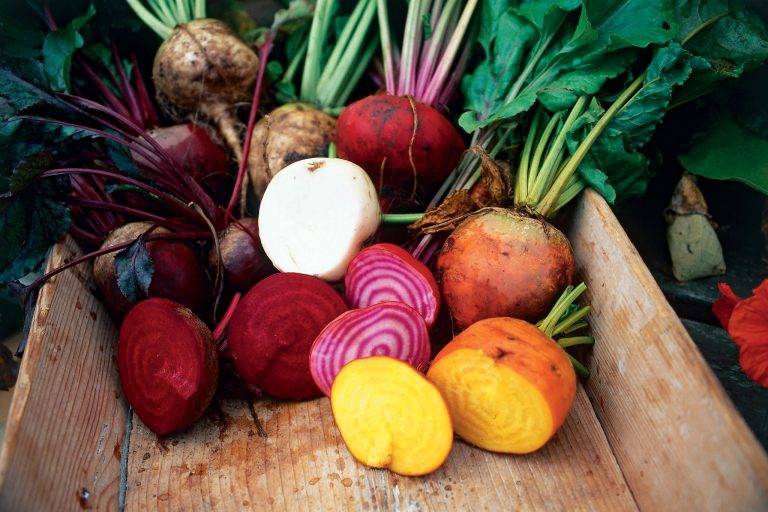As we approach the dearth of winter, nature slows down to rest and so should we. According to traditional Chinese medicine (TCM) this is the most yin portion of the year. Unlike the expansive yang of summer, winter is a time for inward focus, nurturing, and recharging. In terms of the theory of five elements, this season is associated with the water element, and is a time to strengthen our water-related organs: the kidneys and bladder.
Seasonal eating for December aims to support the function of these organs with hydrating, nutrient-dense, restorative, and warming foods. While a variety of foods can meet this criteria, today we will focus on some oft-forgotten root vegetables — which are both in-season and in-tune with our seasonal needs.
Seasonal eating for December
To support the kidneys and bladder and facilitate our inward focus to reserve energy, we should consume a healthy array of nutrient-dense whole grains, nuts, seeds and legumes; cleansing teas like horsetail, burdock and chicory; salty condiments like seaweed, miso, umeboshi plum vinegar and gomasio to draw in and reserve energy; warming stews and soups for hydration; and, of course, an abundance of root vegetables.
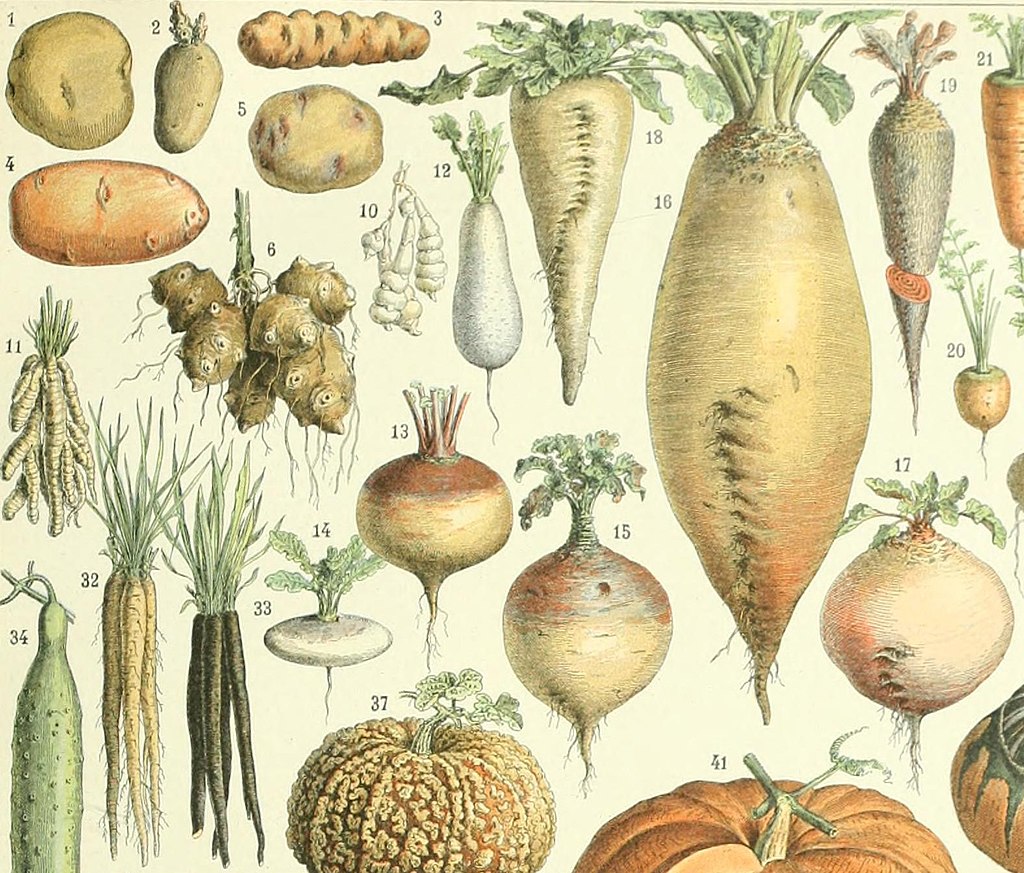
Restorative roots
To get through the winter, many of our botanical friends store up large amounts of energy in their roots — a cache designed to be in perfect harmony with our winter goals. While we commonly consume carrots, onions and potatoes year-round, December is a time to explore a wider range of roots.
As storage organs, roots are a nutritious source of complex carbohydrates; but they also provide valuable antioxidants and necessary fiber. In keeping with their purpose, roots naturally store well and promise potent nutrients throughout the winter. Dabbling in different roots can furnish the winter diet with welcome diversity.
Success
You are now signed up for our newsletter
Success
Check your email to complete sign up
Where to start? Some old-world vegetables — like celeriac, horseradish, parsnips, turnips and yams come to mind; as well as Asian favorites — like daikon radish, lotus root and ginger; and notable natives of the Americas — like Jerusalem artichoke, yuka, and “honorary root vegetables” like winter squash and pumpkin. Although they are technically fruits, these dense, winter storage crops fulfill the same function as roots in terms of diet.
To give you a full appreciation for the value of roots, we’ll highlight a few favorites for closer examination.
Beets
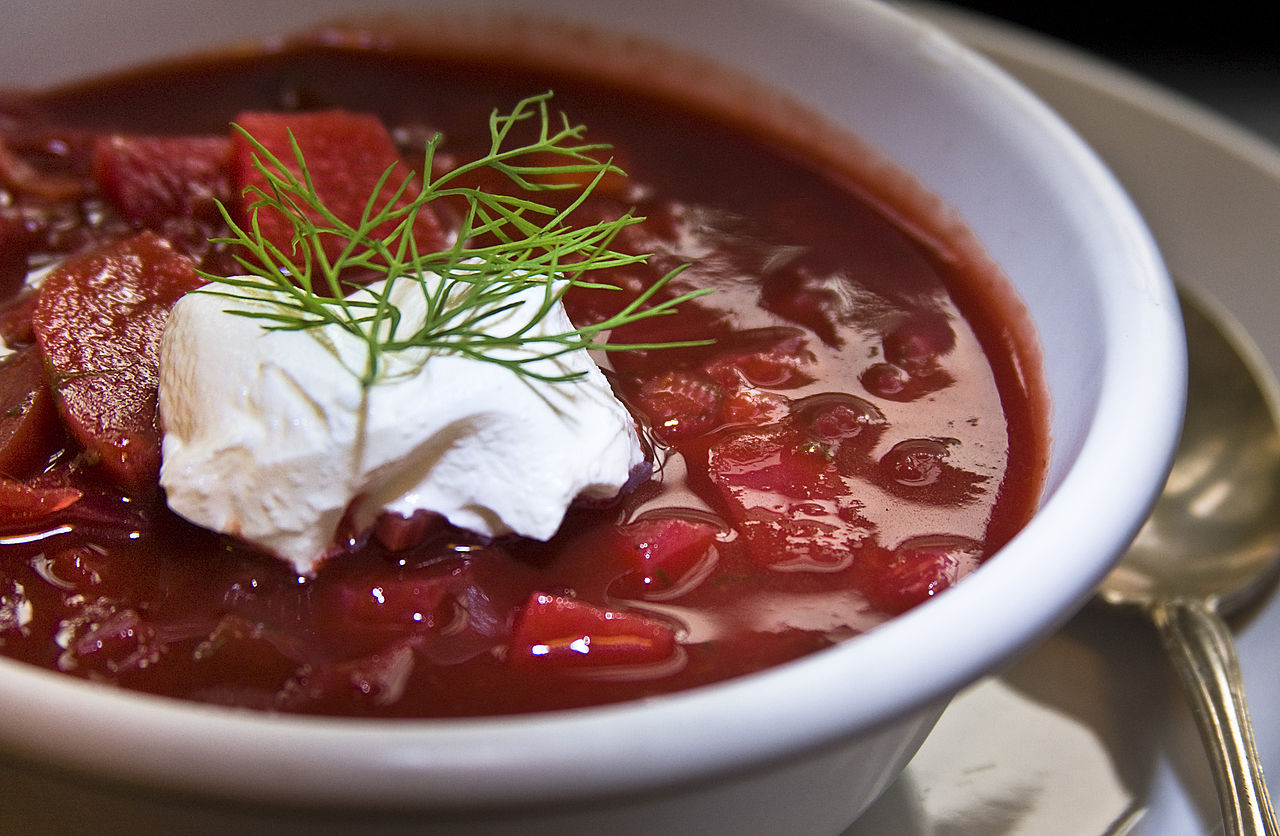
Rich in color and earthy sweetness, beets are loaded with phytonutrients, including the pigment betalain — a powerful antioxidant with anti-inflammatory properties. Consuming beets can be particularly beneficial to individuals suffering from heart disease, liver disease and cancer, or serve as a preventative measure for such chronic illnesses.
Beets are high in nitrates — natural compounds that dilate the blood vessels and increase flow to the heart and brain. Including beets in your diet can help lower blood pressure, improve athletic performance, and enhance cognitive function.
This non-starchy root vegetable is also high in fiber, relative to its carbohydrate content. A diet rich in fiber not only keeps you regular, but also helps maintain healthy blood sugar levels and your ideal weight.
Beets are a natural source of vitamin B9, or folate — a water-soluble nutrient instrumental in maintaining our genetic building blocks, producing red blood cells, and preventing birth defects.
Introduce beets to your family with a delicious, classic borscht.
Daikon radish
Like all radishes, daikon is refreshingly crisp with a spicy kick; but unlike our standard salad radishes, daikons are huge. Snow white and silky smooth, these botanical behemoths are an Asian superfood with medicinal properties.
According to TCM, daikon’s cooling energy helps disperse the heat accumulated from a typical meat-heavy winter diet while supporting the lung meridian, offering antibacterial activity to expel excess phlegm in the respiratory tract. The juicy flesh has antiviral and diuretic properties that help hydrate, cleanse and detoxify the body. Cooked, it balances the stomach and spleen.
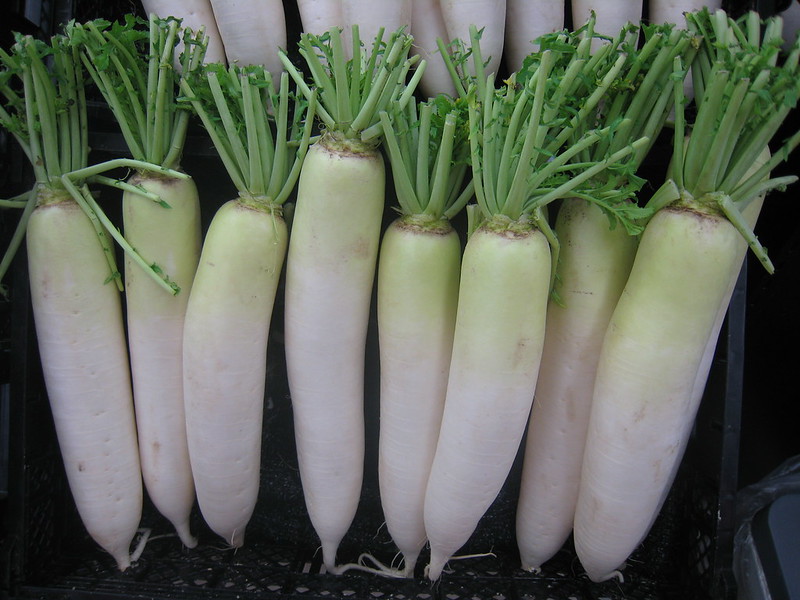
Li Shizhen, the father of Traditional Chinese Medicine, referred to daikon in his Compendium of Materia Medica as “蔬中最有利者 (shū zhōng zuì yǒulì zhě), or the “most beneficial vegetable.”
Daikon is easy to locate in any Asian market. Many farmer’s markets and some large grocery stores will also carry this versatile vegetable. Thin-skinned and easy-to-peel, daikon can be shredded, sliced, diced or julienned with little effort. It is mild enough to eat raw, takes pickling favorably, adds nutritious solids to soups, and can be braised, baked or boiled.
One of my all-time favorites is the classic dim sum “turnip cake.” This rich recipe is somewhat involved and best reserved for a special occasion — like Chinese New Year; but a daikon stew is doable any day.
Daikon stew
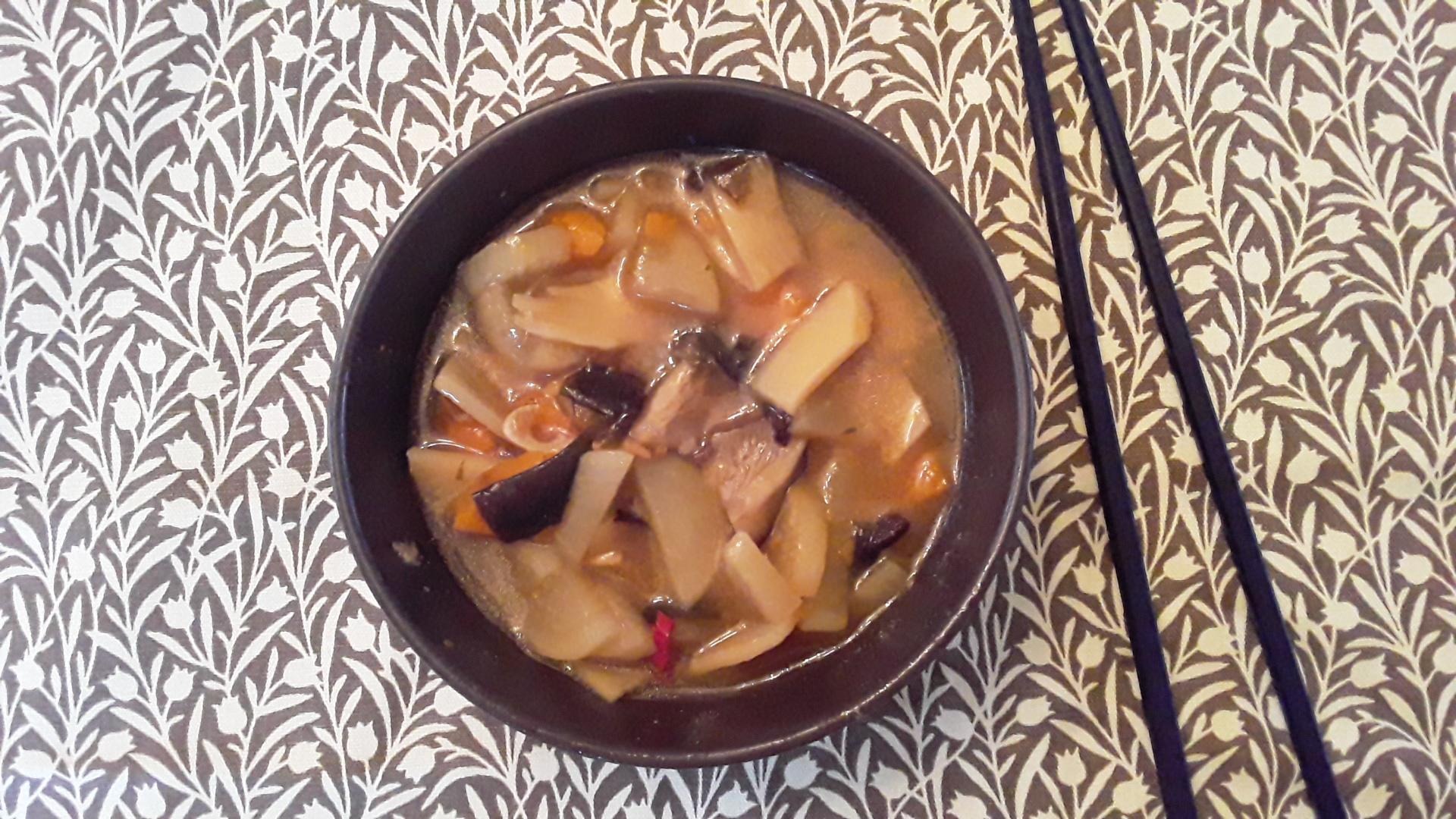
Ingredients:
- ⅓ large daikon, or one small one, peeled and diced
- 1 large sweet potato, peeled and diced
- 9 Shiitake or other fleshy mushrooms, fresh, or dried and rehydrated in hot water
- 4 cups Vegetable stock or other broth (include your mushroom soaking water if applicable).
- 1 small can bamboo shoots or water chestnuts, rinsed
- 1 block of tofu, cubed
- Small piece of Kombu or wakame seaweed, soaked in cool water and sliced
- 1 inch peeled, minced ginger
- 2 scallions, sliced thin
- 1 Tbsp Chinese five-spice powder
- 1 Tbsp rice wine for cooking
- 1 tsp cooking oil
- 2 Tbsp miso paste
- 2 Tbsp starch for thickening
- Soy sauce or Bragg’s liquid aminos to taste
Instructions:
- In a good-sized soup pot, sauté daikon and sweet potato on medium-high heat for 3-4 minutes.
- Add scallions, spices and cooking wine and sauté another few minutes.
- Add broth, sliced mushrooms, tofu, kombu and bamboo shoots or water chestnuts
- Simmer for 15 minutes, or until the sweet potato is tender. If you’re using wakame, add that now.
- Remove ½ cup broth, and divide it evenly.
- Mix one part with cornstarch, tapioca starch, or other thickening agent; mix the other part with miso paste to achieve a smooth consistency.
- Add the starchy broth back and simmer until the broth thickens.
- Remove from heat and stir in the miso and soy sauce to taste.
- Garnish with fresh scallions, thinly sliced hot pepper, or gomasio.
Rutabagas
There is nothing delicate about the rutabaga — a pungent and dense cruciferous cross between cabbage and turnip. It may not look inviting on the surface, but this rugged root has long served as a dietary staple in Northern Europe, valuable for both its nutritional and medicinal value — and the flavor is not bad either!
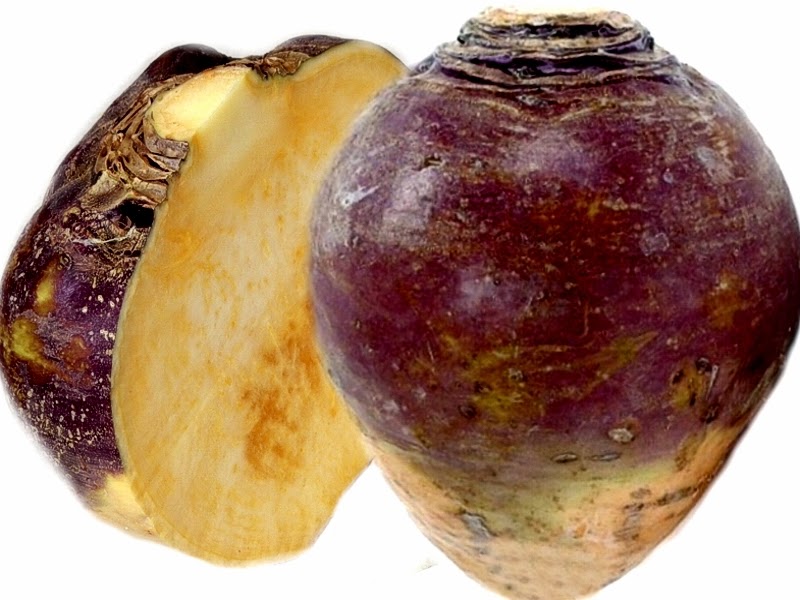
Like most roots, rutabaga aligns with the water element, but it also has characteristics of the earth element, and serves to support digestion.
Nutritionally, rutabaga is an excellent source of Vitamin C and a good source of potassium, magnesium and calcium. It provides important phytonutrients — like lutein and zeaxanthin which contribute to good eye health. Low in fat and high in fiber, vitamins and minerals, rutabagas promote general health and reduce the risk of chronic illnesses.
To prevent dehydration, these vegetables are often coated in food-grade wax, which is more easily removed with a knife than a peeler. Once peeled, the rutabaga can be roasted, boiled, mashed, or even fried like potatoes. The flavor is sweeter than turnips and they are much less starchy than potatoes. When I had a CSA farm, our favorite rutabaga recipe was a tamale pie:
Rutabaga tamale pie
- 2 ½ cups cooked cubed rutabaga, with some cooking water
- 2 ½ cups cooked black beans
- ½ cup chopped onions
- 1 cup tomato sauce or two fresh, diced tomatoes.
- ½ cup or more corn kernels
- Generous mixture of ‘chili’ type spices: (coriander, cumin, cinnamon, cloves, garlic, cayenne, paprika, salt to taste)
Cook the above until you have a nice thick chili. Meanwhile, make your crust:
- 1 cup corn flour
- 1 ½ cup whole wheat pastry flour
- 1 tsp salt
- 1 tsp baking pwd.
- ½ cup shortening
- 3/4 cup (or more) milk of choice
Cut shortening into dry ingredients, add enough milk/soymilk/oatmilk to form a thick dough. Press into a well-oiled pie plate or a deep, cast-iron frying pan. Pre-bake for 10 min, then add the hot chili mixture and bake for an additional 30 – 40 minutes.
Serve hot with shredded cheddar, a dollop of sour cream, or fresh guacamole.



